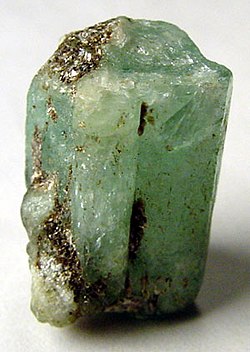For other things of this name, see Emerald (disambiguation).


Emerald (Be3Al2SiO6) is a variety of the mineral beryl, colored green by trace amounts of chromium and sometimes iron. It is highly prized as a gemstone and by weight is the most valuable gemstone in the world, often made more so by inclusions. Beryl has a hardness of 8 on the 10 point Mohs scale of hardness.
Synthetic emerald
Emerald is a rare and valuable gemstone and, as such, provided the incentive for developing synthetic emeralds. Both hydrothermal and flux-growth synthetics have been produced and a method has been developed for producing an emerald overgrowth on colorless beryl. Synthetic emeralds fluoresce a dull red with long wave UV whereas most natural specimens do not. Also both the specific gravities (natural: 2.70 - 2.78, synthetic: 2.66) and refractive indices (natural: 1.576 - 1.582, synthetic: 1.565) of synthetics are slightly lower. Wispy inclusions are common in flux-grown synthetic emeralds.
Culture and folklore
Emerald is regared as the birthstone for May. In some cultures the emerald is the traditional gift for the 55th wedding anniversary.
See also
References
- Sinkankas, John, 1994, Emerald & Other Beryls, Geoscience Press, ISBN 0801971144
- Hurlbut, Cornelius S.; Klein, Cornelis, 1985, Manual of Mineralogy, 20th ed., John Wiley and Sons, New York ISBN 0471805807
- Weinstein, Michael, 1958, The World of Jewel Stones, Sheriden House